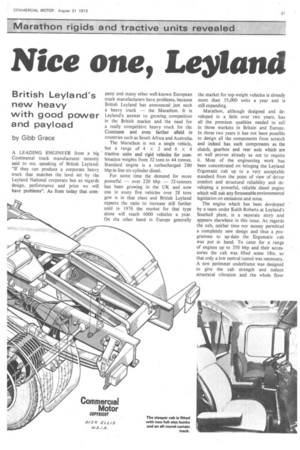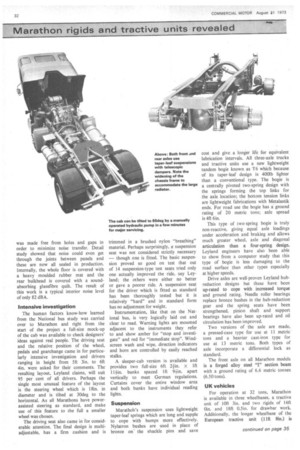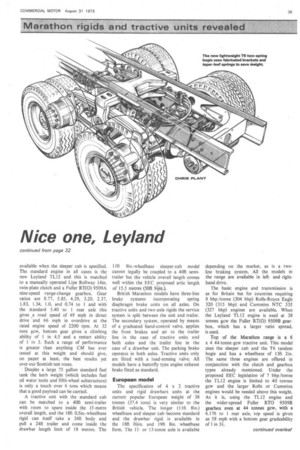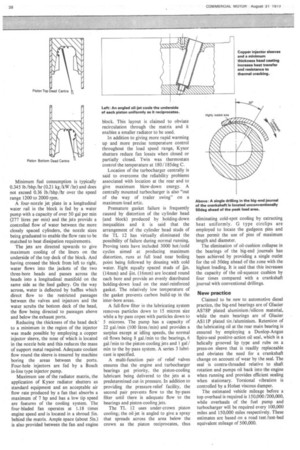Nice one, Leyland
Page 33

Page 34

Page 37

Page 40

If you've noticed an error in this article please click here to report it so we can fix it.
British Leyland's new heavy with good power and payload
by Gibb Grace
A LEADING ENGINEER from a big Continental truck manufacturer recently said to me, speaking of British Leyland: "If they can produce a corporate heavy truck that matches the level set by the Leyland National corporate bus as regards design, performance and price we will have problems". As from today that com pany and many other well-known European truck manufacturers have problems, because British Leyland has announced just such a heavy truck — the Marathon. It is Leyland's answer to growing competition in the British market and the need for a really competitive heavy truck for the Continent and even farther afield in countries such as South Africa and Australia.
The Marathon is not a single vehicle, but a range of 4 x 2 and 6 X 4 tractive units and rigid vehicles for combination weights from 32 tons to 44 tonnes. Standard engine is a turbocharged 280 bhp in-line six-cylinder diesel.
For some time the demand for more powerful — over 220 bhp — 32-tonners has been growing in the UK and now one in every five vehicles over 28 tons gcw is in that class and British Leyland expects the ratio to increase still further until in 1976 the market for that type alone will reach 6000 vehicles a year. On the other hand in Europe generally the market for top-weight vehicles is already more than 55,000 units a year and is still expanding.
Marathon, although designed and developed in a little over two years, has all the premium qualities needed to sell in those markets in Britain and Europe. In those two years it has not been possible to design all the components from scratch and indeed has such components as the clutch, gearbox and rear axle which are so well proven already as not to require it. Most of the engineering work has been concentrated on bringing the Leyland Ergomatic cab up to a very acceptable standard from the point of view of -driver comfort and structural reliability and developing a powerful, reliable diesel engine which will suit any foreseeable environmental legislation on emissions and noise.
The engine which has been developed by a team under Keith Roberts at Leyland's Southall plant, is a separate story and appears elsewhere in this issue. As regards the cab, neither time nor money permitted a completely new design and thus a programme to up-date the Ergomatic cab was put in hand. To cater for a range of engines up to 350 bhp and their accessories the cab was lifted some 18in. so that only a low central tunnel was necessary. A new perimeter underframe was designed to give the cab strength and reduce structural vibration and the whole floor was made free from holes and gaps in order to minimize noise transfer. Detail study showed that noise could even get through the joints between panels and these are now all sealed in production. Internally, the whole floor is covered with a heavy moulded rubber mat and the rear bulkhead is covered with a soundabsorbing glassfibre quilt. The result of this work is a typical interior noise level of only 82 dBA.
Intensive investigation The human factors know-how learned from the National bus study was carried over to Marathon and right from the start of the project a full-size mock-up of the cab was available to check designers' ideas against real people. The driving seat and the relative position of the wheel, pedals and gearchange came in for particularly intensive investigation and drivers ranging in height from 5ft 3in. to 6ft 4in. were asked for their comments. The resulting layout, Leyland claims, will suit 95 per cent of all drivers. Perhaps the single most unusual feature of the layout is the steering wheel which is 18in. in diameter and is tilted at 30deg to the horizontal. As all Marathons have powerassisted steering as standard, and make use of this feature to the full a smaller wheel was chosen.
The driving seat also came in for considerable attention. The final design is multiadjustable, has a firm cushion and is trimmed in a brushed nylon "breathing" material. Perhaps surprisingly, a suspension seat was not considered strictly necessary — though one is fitted. The basic suspension proved so good on test that out of 14 suspension-type test seats tried only one actually improved the ride, say Leyland; the others were either no better or gave a poorer ride. A suspension seat for the driver which is fitted as standard has been thoroughly tested but it is relatively "hard" and in standard form has no adjustment for weight.
Instrumentation, like that on the National bus, is very logically laid out and clear to read. Warning lights are mounted adjacent to the instruments they refer to and show amber for "stop and investigate" and red for "immediate stop". Windscreen wash and wipe, direction indicators and horn are controlled by easily reached stalks.
A sleeper-cab version is available and provides two full-size 6ft 2fin, x lft 11+in. bunks spaced lft 9÷in. apart vertically to meet German regulations. Curtains cover the entire window area and both bunks have individual reading lights.
Suspension Marathoh's suspension uses lightweight taper-leaf springs which are long and supple to cope with bumps more effectively. Nylatron bushes are used in place of bronze on' the shackle pins and save cost and give . a longer life for equivalent lubrication intervals. All three-axle trucks and tractive units use a new lightweight tandem bogie known as T6 which because of its taper-leaf design is 400lb lighter than a conventional type. The bogie is a centrally pivoted two-spring design with the springs forming the top links for the axle location; the bottom tension links are lightweight fabrications with Metalastik ends. For road use the bogie has a ground rating of 20 metric tons; axle spread is 4ft 6in.
This type of two-spring bogie is truly non-reactive, giving equal axle loadings under acceleration and braking and allows much greater wheel, axle and diagonal articulation than a four-spring design. Leyland engineers have also been able to show from a computer study that this type of bogie is less damaging to the road surface than other types especially at higher speeds.
Drive axles are well-proven Leyland hubreduction designs but these have been up-rated to cope with increased torque and ground rating. Needle roller bearings replace bronze bushes in the hub-reduction gear and the spring seats have been strengthened, pinion shaft and support bearings have also been up-rated and oil circulation has been improved.
Two versions of the axle are made, a pressed-case type for use at 11 metric tons and a heavier cast-iron type for use at 13 metric tons. Both types of axle incorporate a differential lock as standard.
The front axle on all Marathon models is a forged alloy steel "I" section beam with a ground rating of 6.6 metric tonnes (6.50 tons).
UK vehicles For operation at 32 tons, Marathon is available in three wheelbases, a tractive unit of 10ft 3in. and two rigids of 16ft Oin. and 18ft 0.5in. for drawbar work. Additionally, the longer wheelbase of the European tractive unit (lift Sin.) is available when the sleeper cab is specified. The standard engine in all cases is the new Leyland TL12 and this is matched to a manually operated Lipe Rollway 14in. twin-plate clutch and a Fuller RT(0) 9309A nine-speed range-change gearbox. Gear ratios are 8.77, 5.85, 4.29, 3.20, 2.37, 1.83, 1.34, 1.0, and 0_74 to 1 and with the standard 5.40 to 1 rear axle this gives a mad speed of 49 mph in direct drive and 66 mph in overdrive at the rated engine speed of 2200 rpm. At 32 tons gcw, bottom gear gives a climbing ability of 1 in 4.5 and a restart ability of I in 5. Such a range of performance is greater than anything CM has ever tested at this weight and should give, on paper at least, the best results yet over our Scottish test route.
• Despite a large 75 gallon standard fuel tank the kerb weight (which includes fuel oil water tools and fifth-wheel substructure) is only a touch over 6 tons which means that a good payload can be carried.
A tractive unit with the standard cab
can be matched to a 40ft semi trailer•with room to spare inside the 15-metre
overall length, and the 18ft 0.5in.-wheelbase rigid can itself take a 24ft body and pull a 24ft trailer and come inside the drawbar length limit of 18 metres. The lift 8in.-wheelbase sleeper cab model cannot legally be coupled to a 40ft semitrailer but the vehicle overall length comes well within the EEC proposed artic length of 15.5 metres (50ft 9fin).
British Marathon models have three-line brake systems incorporating spring diaphragm brake units on all axles. On tractive units and two-axle rigids the service system is split between the unit and trailer. The secondary system, operated by means of a graduated hand-control valve, applies the front brakes and air to the trailer line in the case of tractive units and both axles and the trailer line in the case of a drawbar unit. The parking brake operates in both axles. Tractive units only are fitted with a load-sensing valve. All models have a butterfly type engine exhaust brake fitted as standard.
European model The specification of 4 x 2 tractive units and rigid drawbars units at the current popular European weight of 38 tonnes (37.4 tons) is very similar to the British vehicle. The longer (lift 8in.) wheelbase and sleeper cab become standard and the drawbar rigid is available in the 18ft 0+in. and 19ft 8in. wheelbase form. The 11or 13-tonne axle is available depending on the market, as is a twoline braking system. All the models in the range are available in leftand righthand drive.
The basic engine and transmission is as for Britain but for countries requiring 8 bhp /tonne (304 bhp) Rolls-Royce Eagle 320 (315 bhp) and Cummins NTC 335 (327 bhp) engines are available. When the Leyland TL12 engine is used at 38 tonnes gcw the Fuller RT(0) 9509B gearbox, which has a larger ratio spread, is used.
Top of the Marathon range is a 6 x 4 .44-tonne-gcw tractive unit. This model uses the sleeper cab and the T6 tandem bogie and has a wheelbase of 13ft 2in. The same three engines are offered in conjunction with the clutch and gearbox types already mentioned. Under the proposed EEC legislation of 7 bhp /tonne the TL12 engine is limited to 40 tonnes gew and the larger Rolls or Cummins engines would be needed above this weight. As it is, using the TL12 engine and the wider-spread Fuller RTO 9509B gearbox even at 44 tonnes gcw, with a 6.176 to 1 rear axle, top speed is given as 58 mph with a bottom gear gradeability of 1 in 3+.
Minimum fuel consumption is typically 0.345 lb /bhp/hr (0.21 kg /kW /hr) and does not exceed 0.36 lb /bhp /hr over the speed range 1200 to 2000 rpm.
A four-nozzle jet plate in a longitudinal water rail in the block is fed by a water pump with a capacity of over 50 gal per min (277 litres per min) and the jets provide a controlled flow of water between the more closely spaced cylinders, the nozzle sizes being graduated to enable the flow rate to be matched to heat dissipation requirements.
The jets are directed upwards to give maximum cooling of the liners on the underside of the top deck of the block. And having crossed the block from left to right, water flows into the jackets of the two three-bore heads and passes across the heads into a longitudinal manifold on the same side as the feed gallery. On the way across, water is deflected by baffles which direct flow to the restricted passages between the valves and injectors and the water scrubs the bottom deck of the head, the flow being directed to passages above and below the exhaust ports.
Reducing the thickness of the head deck ' to a minimum in the region of the injector was made possible by employing a copper injector sleeve, the nose of which is located in the nozzle hole and this reduces the mass of support metal required. Adequate coolant flow round the sleeve is ensured by machine boring the areas between the ports. Four-hole injectors are fed by a Bosch in-line type injector pump.
Maximum use of the radiator matrix, the application of Kysor radiator shutters as standard equipment and an acceptable air flow rate produced by a fan that absorbs a maximum of 7 hp and has a low tip speed are features of the cooling system. The four-bladed fan operates at 1.18 times engine speed and is located in a shroud Sin. behind the matrix. Ample space (about 5in.) is also provided between the fan and engine block. This layout is claimed to obviate recirculation through the matrix and it enables a smaller radiator to be used.
In addition to giving more rapid warming up and more precise temperature control throughout the load speed range, Kysor shutters reduce fan losses when closed or partially closed. Twin wax thermostats control the temperature at 180 /185deg C.
Location of the turbocharger centrally is said to overcome the reliability problems associated with location at the rear and to give maximum blow-down energy. A centrally mounted turbocharger is also "out of the way of trailer swing" on a maximum-load artic.
Premature gasket failure is frequently caused by distortion of the cylinder head (and block) produced by holding-down inequalities and it is said that the arrangement of the cylinder head studs of the TL 12 has virtually eliminated the possibility of failure during normal running. Proving tests have included 3000 hot/cold cycles aimed at producing maximum distortion, runs at full load near boiling point being followed by dousing with cold water. Eight equally spaced studs of ain.
(14mm) and (16mm) are located round each bore and provide an evenly distributed holding-down load on the steel-reinforced gasket. The relatively low temperature of the gasket prevents carbon build-up in the inter-bore areas.
A full-flow filter in the lubricating system removes particles down to 15 micron size while a by-pass copes with particles down to 5 microns. The pump has a capacity of 22 gal/min (100 litres /min) and provides a surplus except at idling speeds, the normal oil flows being 8 gal /min to the bearings, 6 gal/min to the piston-cooling jets and 1 gal/ mm to the by-pass system. A series 3 lubricant is specified.
A multi-function pair of relief valves ensures that the engine and turbocharger bearings get priority, the piston-cooling lubricant being delivered to the jets at a predetermined cut-in pressure. In addition to providing the pressure-relief facility, the second pair prevents flow to the by-pass filter until there is adequate flow to the bearings and piston-cooling jets.
The TL 12 uses under-crown piston cooling; the oil-jet is angled to give a spray that spreads across the area below the crown as the piston reciprocates. thus eliminating cold-spot cooling by extracting heat uniformly. G type circlips are employed to locate the gudgeon pins and thus permit the use of pins of maximum length and diameter.
The elimination of oil-cushion collapse in the bearings of the big-end journals has been achieved by providing a single outlet for the oil 50deg ahead of the zone with the highest loading. It is said that this increases the capacity of the oil-squeeze cushion by four times compared with a crankshaft journal with conventional drillings.
New practice Claimed to be new to automotive diesel practice, the big-end bearings are of Glacier AS78P plated aluminium /silicon material, while the main bearings are of Glacier ASI1P plated tin /aluminium. Retention of the lubricating oil at the rear main bearing is ensured by employing a Dunlop-Angus Spiro-seal positive-action oil seal, which is a helically grooved lip type and rubs on a press-on sleeve that is readily replaceable and obviates the need for a crankshaft change on account of wear by the seal. The seal is contra-threaded relative to shaft rotation and pumps oil back into the engine when running and provides efficient sealing when stationary. Torsional vibration is controlled by a Holset viscous damper.
The estimated vehicle mileage before a top overhaul is required is 150,000/200,000, while overhauls of the fuel pump and turbocharger will be required every 100,000 miles and 150,000 miles respectively. These estimates are based on a road test/test-bed equivalent mileage of 500,000.












































































































